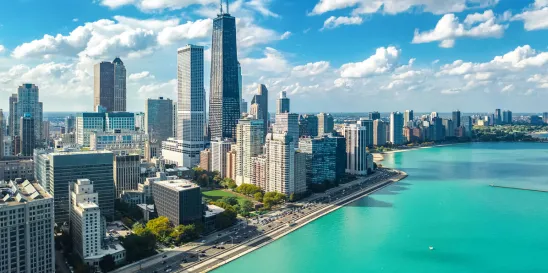On December 14, 2023, the Cook County Board of Commissions (Board) passed an ordinance that transforms the county’s current paid sick leave ordinance to a new paid leave ordinance, effective December 31, 2023. The provisions of the new Cook County Paid Leave Ordinance (Ordinance) largely follow the requirements of the upcoming Illinois Paid Leave for All Workers Act, but for many employers, the Ordinance will bring about sweeping, last-minute changes to their policies during the height of the holiday season.
When will the Ordinance take effect?
The Ordinance will take effect on December 31, 2023.
How does the Ordinance interact with the Illinois Paid Leave for All Workers Act?
The Ordinance effectively brings the entire county in line with the requirements of the Illinois Paid Leave for All Workers Act (PLAW), which takes effect January 1, 2024. Because PLAW expressly carves out any employer covered by a local ordinance requiring the employer to provide paid leave (including paid sick leave) to employees, employers with employees covered by the current Cook County Paid Sick Leave Ordinance may have not been preparing for PLAW. Now, that is no longer an option. Even if a municipality opts out of the Ordinance, as many did with respect to the current Paid Sick Leave Ordinance, they will still be covered by PLAW.
How does the Ordinance interact with the City of Chicago’s Paid Leave and Paid Sick and Safe Leave Ordinance?
As we informed you just last week, implementation of the Chicago ordinance has been delayed until July 1, 2024. The Ordinance is silent on how it will interact with any existing paid leave ordinances within Cook County, and the Board has not issued any guidance on the issue. The county has stated that it will issue additional guidance on the Ordinance by January 1, 2024, which hopefully will provide clarity on this topic.
What types of leave does the Ordinance require?
As the Ordinance’s name suggests, Cook County employees will now be eligible for paid leave that can be used for any purpose.
Which employers are covered?
The Ordinance applies to every employer with at least one employee in Cook County.
Which employees accrue leave under the Ordinance?
The Ordinance applies to virtually all employees in the county. Unlike the current Paid Sick Leave Ordinance, the new Ordinance does not have an hours-worked threshold.
Except for certain domestic workers, independent contractors are not covered by the Ordinance.
How does paid leave accrue?
Paid leave accrues at the rate of one hour per 40 hours worked, which is the same as PLAW’s requirement. Exempt employees are assumed to work 40 hours per week, unless they normally work less than 40 hours in a workweek, in which case their accrual will be based on that lower number of hours.
Are there accrual and usage caps?
Employers can cap the amount of paid leave accrued and used during each 12-month period at 40 hours.
Can employers choose what 12-month period to use?
Yes, the Ordinance expressly states that employers can pick their own 12-month period to use when tracking paid leave accrual, use, and carryover. If an employer changes its 12-month period, then it must provide employees with advance written notice of the change, as well as documentation of their balance of hours worked, paid leave accrued and taken, and remaining paid leave balance.
Does the Ordinance allow for waiting periods before employees may use paid leave?
Yes, employers may implement a waiting period of up to 90 calendar days, which runs from an employee’s commencement of employment. Notably, the Ordinance also allows a waiting period for current employees, as it provides that covered employees will be entitled to begin using paid leave 90 days following commencement of employment or the Ordinance’s effective date (December 31, 2023), whichever is later, meaning that current employees may not use paid leave until March 30, 2024.
What happens to employees’ sick leave banks when the Paid Sick Leave Ordinance converts to the new Ordinance?
The Ordinance is silent on this issue, though the Board may publish guidance prior to the end of the year.
What increments of paid leave can employers require employees to use?
Employers may require employees to use paid leave in increments of no more than two hours. If an employee’s regularly scheduled workday is less than two hours, then the minimum increment that can be imposed for that employee will be the number of hours in their regular workday.
For what purposes can employees use paid leave, and what requirements can employers impose on use of paid leave?
As with PLAW, paid leave under the Ordinance can be used for any reason, and the Ordinance prohibits employers from requesting the reason an employee uses paid leave or requiring documentation supporting an employee’s use of paid leave. In addition, employees have the right to choose whether to use available paid leave before using any other leave provided by the employer or under Illinois law.
However, as with PLAW, employers can require up to seven days advance notice of an employee’s intention to use paid leave under the Ordinance when the need for leave is foreseeable. (If the need for leave is not foreseeable, then notice just must be as soon as practicable.) Employers also may establish “reasonable” written notice requirements for employees to use paid leave (whether leave is foreseeable or not). If an employer changes its notice requirements, it must inform employees of the changes within five calendar days.
In addition, because the Ordinance is intended to follow PLAW, it is likely that the Board also will adopt rules allowing employers to deny requests for leave for similar reasons as under PLAW (i.e., when the use of leave would impact continuity of operations).
Is carryover required?
Yes, employees are permitted to carry over all unused paid leave from one 12-month period to the next if an employer uses an accrual system for paid leave. However, employers may cap an employee’s usage of paid leave to 40 hours in that 12-month period.
Does the Ordinance allow for frontloading?
Yes, frontloading is allowed. If an employer frontloads 40 hours of paid leave, then it does not need to track accrual or allow for carryover of unused paid leave from one 12-month period to the next. Any unused paid leave remaining at the end of the 12-month period would be forfeited.
Do employers need to pay out unused paid leave upon an employee’s separation from employment?
The Ordinance says that paid leave does not need to be paid out upon separation, but that’s not the end of the story. The Ordinance also says that nothing in the Ordinance is meant to limit an employee’s right to payout of unused vacation time at separation under the Illinois Wage Payment and Collection Act. Therefore, even though the Ordinance, itself, does not require payout of paid leave upon separation, the Illinois Department of Labor may consider paid leave under the Ordinance to be akin to “vacation time” that must be paid out upon separation. Employers who have been preparing for PLAW and following the recent developments with the City of Chicago’s Paid Leave and Paid Sick and Safe Leave Ordinance will note that similar issues exists under those laws as well.
What if an employer has an existing vacation, PTO, or sick leave policy that is more generous than the Ordinance?
Similar to PLAW, the Ordinance states that an employer who provides “any type of paid leave policy” that provides at least 40 hours of paid leave in a 12-month period “is not required to modify the policy” so long as that policy allows the employee “to take paid leave for any reason.” As with PLAW, it is a bit unclear whether this extends to all of the Ordinance’s other provisions, such as requirements regarding minimum notice and increments of use. Hopefully, the implementing rules and guidance will provide more insight regarding what existing policies are considered compliant with the Ordinance.
Does the Ordinance address “unlimited” PTO policies?
It does not address “unlimited” PTO policies, but given the extent to which the Ordinance is modeled after PLAW, employers can expect the county to take a similar approach with respect to “unlimited” PTO policies as the Illinois Department of Labor is doing under PLAW. Specifically, the county likely will look at whether employees actually do, or have the ability to, take at least 40 hours of PTO in a 12-month period under their employer’s “unlimited” PTO policy.
What if an employee is covered by a collective bargaining agreement?
The Ordinance does not apply to employees in the construction industry who are covered by a collective bargaining agreement (CBA), nor does it impact the terms of CBAs in force prior to January 1, 2024. However, any collective bargaining agreement entered into or amended after January 1, 2024 may waive the Ordinance’s requirements so long as the waiver is in “clear and unambiguous terms.” How the Ordinance will address potential preemption concerns remains unclear.
What are the employer’s notice obligations under the Ordinance?
In addition to keeping records regarding each employee’s accrual and use of paid leave, employers are required to display a poster regarding the Ordinance (to be provided by the county) in the workplace. Employers also must provide an employee with a notice about their rights under the Ordinance at the commencement of employment. The city also will provide a model form for this notice.
Employers that use an accrual basis for paid leave under the Ordinance must also provide an employee with notice of the amount of paid leave accrued or used upon the employee’s request in accordance with the employer’s reasonable notice requirements for such requests.
What are the penalties for non-compliance?
Unfortunately for employers, employees continue to have the right (just like under the current Paid Sick Leave Ordinance) to sue their employers for non-compliance, and there is no grace period for employers. Employees also are not required to file an administrative complaint before filing suit. Employees who prevail in a civil action can recover damages equal to three times the amount of paid leave denied or lost, as well as interest, costs, and attorneys’ fees.
As an alternative, employees may file an administrative complaint with the Cook County Commission on Human Rights (Commission), but the Commission will not order any remedies for violations until February 1, 2024, giving employers a small grace period to get into compliance. Employees who file an administrative complaint with the Commission may recover from their employer the amount of paid leave denied or lost, compensatory damages, and a penalty of between $500-1000. Employers also may be liable for a penalty of $2,500 per violation.
So, what should employers do now?
For employers who have been preparing for PLAW, the new Ordinance will not bring many, if any, changes. But for employers who intended to comply only with the current Paid Sick Leave Ordinance in the coming year, the new Ordinance may require substantial changes in a short period of time. Employers should carefully review existing policies against the Ordinance’s requirements. While compliance with the particulars of the Ordinance may seem ominous, employers may find their existing policies are already compliant with many of them.





 />i
/>i
